Related Research Articles

Lingerie is a category of primarily women's clothing including undergarments, sleepwear, and lightweight robes. The choice of the word is often motivated by an intention to imply that the garments are alluring, fashionable, or both. In a 2015 US survey, 75% of women and 26% of men reported having worn sexy lingerie in their lifetime.

A model is a person with a role either to promote, display or advertise commercial products or to serve as a visual aid for people who are creating works of art or to pose for photography. Though models are predominantly female, there are also male models, especially to model clothing. Models may work professionally or casually.

A corset is a support garment commonly worn to hold and train the torso into a desired shape, traditionally a smaller waist or larger bottom, for aesthetic or medical purposes, or support the breasts. Both men and women are known to wear corsets, though this item was for many years an integral part of women's wardrobes.

The waist is the part of the abdomen between the rib cage and hips. On people with slim bodies, the waist is the narrowest part of the torso.

The joint European standard for size labelling of clothes, formally known as EN 13402 Size designation of clothes, is a European standard for labelling clothes sizes which has been partially adopted, and aims to make it easier to find and select fitting clothes. The standard is based on body dimensions measured in centimetres, and as such aims to allow for finding fitting clothing sizes by measuring the body with a tape measure or by comparing to already fitting clothing which conforms to the EN 13402 standard. The standard can therefore contribute to more environmentally friendly trade as it can lead to less return of clothes bought on the internet.
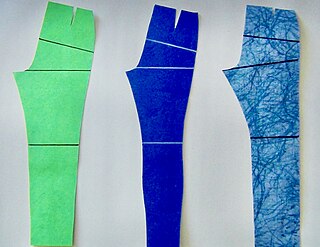
In sewing and fashion design, a pattern is the template from which the parts of a garment are traced onto woven or knitted fabrics before being cut out and assembled. Patterns are usually made of paper, and are sometimes made of sturdier materials like paperboard or cardboard if they need to be more robust to withstand repeated use. The process of making or cutting patterns is sometimes compounded to the one-word Patternmaking, but it can also be written pattern(-)making or pattern cutting.
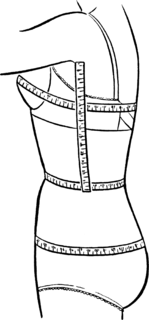
Bust/waist/hip measurements are a common method of specifying clothing sizes. They match the three inflection points of the female body shape. In human body measurement, these three sizes are the circumferences of the bust, waist and hips; usually rendered as xx–yy–zz in inches, or centimeters. The three sizes are used mostly in fashion, and almost exclusively in reference to women, who, compared to men, are more likely to have a narrow waist relative to bust and hips. An important difference exists when measuring men's hips for most fashion design purposes. In these instances, men's hips are measured at the genitals.
Vanity sizing, or size inflation, is the phenomenon of ready-to-wear clothing of the same nominal size becoming bigger in physical size over time. This has been documented primarily in the United States and the United Kingdom. The use of US standard clothing sizes by manufacturers as the official guidelines for clothing sizes was abandoned in 1983. In the United States, although clothing size standards exist, most companies do not use them any longer.
Sweater design is a specialization of fashion design in which knitted sweaters are designed to fulfill certain aesthetic, functional and commercial criteria. The designer typically considers factors such as the insulating power of the sweater ; the fashion of its colors, patterns, silhouette and style lines, particularly the neckline and waistline; the convenience and practicality of its cut; and in commercial design, the cost of its production and the profitability of its price point. Sweater designs are often published in books and knitting magazines. Sweater design is an old art, but continues to attract new designers such as Nicky Epstein and Meg Swansen.
U.S. standard clothing sizes for women were originally developed from statistical data in the 1940s and 1950s. At that time, they were similar in concept to the EN 13402 European clothing size standard, although individual manufacturers have always deviated from them, sometimes significantly.

The hourglass figure is one of four traditional female body shapes described by the fashion industry. The other shapes are the rectangular, inverted triangle, and spoon/pear. The hourglass shape is defined by a woman's body measurements- the circumference of the bust, waist and hips. Hourglass body shapes have a wide bust, a narrow waist, and wide hips with a similar measurement to that of the bust. This body shape is named for its resemblance to that of an hourglass where the upper and lower half are wide and roughly equal while the middle is narrow in circumference, making the overall shape wide-narrow-wide. Women who exhibit the hourglass figure have been shown to be more admired, which can put pressure on women whose body shapes are noticeably different to strive to achieve the hourglass figure. This can lead to body dissatisfaction which can cause eating disorders in young women from all over the globe.
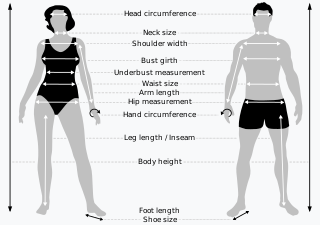
Clothing sizes are the sizes with which garments sold off-the-shelf are labeled. Sizing systems vary based on the country and the type of garment, such as dresses, tops, skirts, and trousers. There are three approaches:

Bra size indicates the size characteristics of a bra. While there are a number of bra sizing systems in use around the world, the bra sizes usually consist of a number, indicating the size of the band around the woman's torso, and one or more letters that indicate the breast cup size. Bra cup sizes were invented in 1932 while band sizes became popular in the 1940s. For convenience, because of the impracticality of determining the size dimensions of each breast, the volume of the bra cup, or cup size, is based on the difference between band length and over-the-bust measurement.
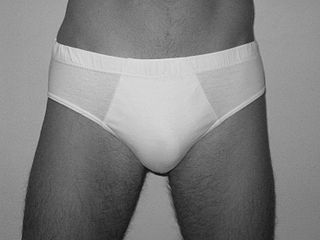
Briefs are a type of short, form-fitting underwear and swimwear, as opposed to styles where material extends down the thighs. Briefs have various different styles, usually with a waistband attached to fabric that runs along the pelvis to the crotch and buttocks, and are worn by both men and women. Swim briefs are a variation used as swimwear.
A bra, short for brassiere or brassière, is a form-fitting undergarment that is primarily used to support and cover women's breasts. It can serve a range of other practical and aesthetic purposes, including enhancing or reducing the appearance of breast size and creating cleavage. Bras can also serve specific functions, such as nursing bras to facilitate breastfeeding or sports bras to minimize discomfort during exercise.
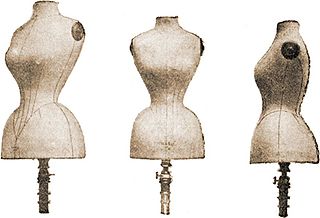
A dress form is a three-dimensional model of the torso used for fitting clothing that is being designed or sewed. When making a piece of clothing, it can be put on the dress form so one can see the fit and drape of the garment as it would appear on a body, and make adjustments or alterations. Dress forms come in all sizes and shapes for almost every article of clothing that can be made. Dress forms in the standard clothing sizes are used to make patterns, while adjustable dress forms allow garments to be tailored to fit a specific individual.

Undergarments or underwear are items of clothing worn beneath outer clothes, usually in direct contact with the skin, although they may comprise more than a single layer. They serve to keep outer garments from being soiled or damaged by bodily excretions, to lessen the friction of outerwear against the skin, to shape the body, and to provide concealment or support for parts of it. In cold weather, long underwear is sometimes worn to provide additional warmth. Special types of undergarments have religious significance. Some items of clothing are designed as undergarments, while others, such as T-shirts and certain types of shorts, are appropriate both as undergarments and as outer clothing. If made of suitable material or textile, some undergarments can serve as nightwear or swimsuits, and some are intended for sexual attraction or visual appeal.

Female body shape or female figure is the cumulative product of a woman's skeletal structure and the quantity and distribution of muscle and fat on the body.

A virtual dressing room is the online equivalent of an in-store changing room.
References
- 1 2 Fasanella, Kathleen (2010-08-17). "What is a fit model?". Fashion-Incubator:Lessons from the Sustainable Factory Floor. Retrieved 2016-04-20.
- ↑ Vogt, Peter (2007). Career Opportunities in the Fashion Industry. Infobase Publishing. pp. 44–. ISBN 9780816068418 . Retrieved 2013-08-08.
- ↑ "Fit Model" . Retrieved 2016-04-20.
- ↑ Flanagan, Jenna (2011-02-18). "Fashion Fit Models: Rarely Seen But Essential to the Runway". WNYC. Archived from the original on 2015-05-31. Retrieved 2013-08-08.